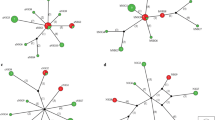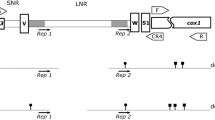Abstract
In the current study, Fasciola hepatica strains of sheep with different degrees of resistance to anthelmintics were analyzed by sequencing the cytochrome C oxidase (COX1) and the NADH dehydrogenase (NAD1) subunits. The strains were as follows: LS, susceptible to all drugs tested; CS, resistant to albendazole and triclabendazole; and SV, resistant to albendazole and clorsulon. The molecular characterization was done in eggs recovered from sheep infected by LS and CS. In relation to SV, eggs were recovered before (SV0) and after a treatment with albendazole (SVA) and clorsulon (SVC). Nested PCRs were carried out to amplify a fragment of 798 bp of the COX1 subunit and 870 bp of the NAD1 subunit. The pairwise sequence identity between eggs was analyzed for each strain. Population diversity indices, neutrality indices, and the degree of gene flow among the strains were evaluated. As a result, we have shown that there was homogeneity in the demographic expansion of the studied strains, and, according to the pairwise fixation index, these were not genetically differentiated. Although we found that the resistant strains had lower pairwise percentage similarities, higher haplotype diversity, and higher frequencies of specific SNPs, especially in the COX1 subunit, these differences were not very significant. Therefore, we conclude that the presence of adult flukes resistant to anthelmintics does not result in significant higher genetic diversity in the mtDNA of their eggs.

Similar content being viewed by others
References
Alvarez-Sánchez MA, Mainar-Jaime RC, Pérez-García J, Rojo-Vázquez FA (2006) Resistance of Fasciola hepatica to triclabendazole and albendazole in sheep in Spain. Vet Rec 159:424–425
Avise JC, Wollenberg K (1997) Phylogenetics and the origin of species. Proc Natl Acad Sci 94:7748–7755
Boore JL (1999) Animal mitochondrial genomes. Nucleic Acids Res 27:1767–1780
Boray JC (1985) Flukes of domestic animals. In: Gaafar SM, Howard WE, Marsh RE (eds) Parasites, pests and predators. Elsevier Pub, Amsterdam, pp 179–218
Clement M, Posada D, Crandall K (2000) TCS: a computer program to estimate gene genealogies. Mol Ecol 9:1657–1660
Cornell SJ, Isham VS, Smith G, Grenfell BT (2003) Spatial parasite transmission, drug resistance and the spread of rare genes. Proc Natl Acad Sci 100:7401–7405
Elliott T, Muller A, Brockwell Y, Murphy N, Grillo V, Toet HM, Anderson G, Sangster N, Spithill TW (2014) Evidence for high genetic diversity of NAD1 and COX1 mitochondrial haplotypes among triclabendazole resistant and susceptible populations and field isolates of Fasciola hepatica (liver fluke) in Australia. Vet Parasitol 200:90–96
Excoffier L, Laval G, Schneider S (2007) Arlequin (version 3.0): an integrated software package for population genetics data analysis. Evol Bioinformatics Online 1:47–50
Fletcher HL, Hoey EM, Orr N, Trudgett A, Fairweather I, Robinson MW (2004) The occurrence and significance of triploidy in the liver fluke, Fasciola hepatica. Parasitology 128:69–72
Fu Y (1997) Statistical tests of neutrality of mutations against population growth, hitchhiking and background selection. Genetics 147:915–925
Krämer F, Schnieder T (1998) Sequence heterogeneity in a repetitive DNA element of Fasciola. Int J Parasitol 28:1923–1929
Lydeard C, Mulvey M, Aho JM, Kennedy PK (1989) Genetic variability among natural populations of the liver fluke Fascioloides magna in white-tailed deer, Odocoiles virginianus. Can J Zool 67:2021–2025
Martínez-Ibeas AM, Martínez-Valladares M, González-Lanza C, Miñambres B, Manga-González MY (2011) Detection of Dicrocoelium dendriticum larval stages in mollusc and ant intermediate hosts by PCR, using mitochondrial and ribosomal internal transcribed spacer (ITS-2) sequences. Parasitology 24:1–8
Martínez-Valladares M, Cordero-Pérez C, Castañón-Ordóñez L, Famularo MR, Fernández-Pato N, Rojo-Vázquez FA (2010a) Efficacy of a moxidectin/triclabendazole oral formulation against mixed infections of Fasciola hepatica and gastrointestinal nematodes in sheep. Vet Parasitol 174:166–169
Martínez-Valladares M, Famularo MR, Fernández-Pato N, Castañón-Ordóñez L, Cordero-Pérez C, Rojo-Vázquez FA (2010b) Efficacy of nitroxynil against Fasciola hepatica resistant to triclabendazole in a naturally infected sheep flock. Parasitol Res 107:1205–1211
Martínez-Valladares M, Cordero-Pérez C, Rojo-Vázquez FA (2013a) Efficacy of an anthelmintic combination in sheep infected with Fasciola hepatica resistant to albendazole and clorsulon. Exp Parasitol 6:59–62
Martínez-Valladares M, Robles-Pérez D, Martínez-Pérez JM, Cordero-Pérez C, Famularo MR, Fernández-Pato N, González-Lanza C, Castañón-Ordóñez L, Rojo-Vázquez FA (2013b) Increase in prevalence of gastrointestinal nematodes and Fasciola hepatica infections in sheep in the Northwest of Spain: relation to climatic conditions and/or man-made environmental modifications? Parasites Vectors 27:282–290
Mas-Coma MS, Esteban JG, Bargues MD (1999) Epidemiology of human fascioliasis: a review and proposed new classification. Bull World Health Organ 77:340–346
Mas-Coma S, Bargues MD, Valero MA (2005) Fascioliasis and other plant-borne trematode zoonoses. Int J Parasitol 35:1255–1278
Moazeni M, Sharifiyazdi H, Izadpanah A (2012) Characterization of Fasciola hepatica genotypes from cattle and sheep in Iran using cytochrome C oxidase gene (CO1). Parasitol Res 110:2379–2384
Moll L, Gaasenbeek CP, Vellema P, Borgsteede FH (2000) Resistance of Fasciola hepatica against triclabendazole in cattle and sheep in the Netherlands. Vet Parasitol 91:153–158
Mooney L, Good B, Hanrahan JP, Mulcahy G, de Waal T (2009) The comparative efficacy of four anthelmintics against a natural acquired Fasciola hepatica infection in hill sheep flock in west of Ireland. Vet Parasitol 164:201–205
Mulvey M, Aho JM, Lydeard C, Leberg PL, Smith MH (1991) Comparative population genetic structure of a parasite (Fascioloides magna) and its definitive host. Evolution 45:1628–1640
Olaechea F, Lovera V, Larroza M, Raffo F, Cabrera R (2011) Resistance of Fasciola hepatica against triclabenzadole in cattle in Patagonia (Argentina). Vet Parasitol 178:364–366
Posada D, Crandall KA (2011) Intraspecific gene genealogies: trees grafting into networks. Trends Ecol Evol 16:37–45
Robles-Pérez D, Martínez-Pérez JM, Rojo-Vázquez FA, Martínez-Valladares M (2013) The diagnosis of fasciolosis in faeces of sheep by means of a PCR and its application in the detection of anthelmintic resistance in sheep flocks naturally infected. Vet Parasitol 197:277–282
Rojo-Vázquez FA, Meana A, Valcárcel F, Martínez-Valladares M (2012) Update on trematode infections in sheep. Vet Parasitol 30:15–38
Rozas J, Sánchez-Del Barrio JC, Messeguer X, Rozas R (2003) DnaSP, DNA polymorphism analyses by the coalescent and other methods. Bioinformatics 19:2496–2497
Semyenova SK, Morozova EV, Chrisanfova GG, Gorokhov VV, Arkhipov IA, Moskvin AS, Movsessyan SO, Ryskov AP (2006) Genetic differentiation in eastern European and western Asian populations of the liver fluke, Fasciola hepatica, as revealed by mitochondrial NAD1 and COX1 genes. J Parasitol 92:525–530
Shadel GS, Clayton DA (1997) Mitochondrial DNA maintenance in vertebrates. Annu Rev Biochem 66:409–435
Tajima F (1989) Statistical method for testing the neutral mutation hypothesis by DNA polymorphism. Genetics 123:585–595
Templeton AR, Crandall KA, Sing CF (1992) A cladistic analysis of phenotypic associations with haplotypes inferred from restriction endonuclease mapping and DNA sequence data. III. Cladogram estimation. Genetics 132:619–633
Thompson JD, Higgins DG, Gibson TJ (1994) Clustal wimproving the sensitivity of progressive multiple sequence alignment through sequence weighting, position-specific gap penalties and weight matrix choice. Nucleic Acids Res 22:4673–4680
Vara-Del Río MP, Villa H, Martinez-Valladares M, Rojo-Vázquez FA (2007) Genetic heterogeneity of Fasciola hepatica isolates in the northwest of Spain. Parasitol Res 101:1003–1006
Walker SM, Prodöhl PA, Fletcher HL, Hanna RE, Kantzoura V, Hoey EM, Trudgett A (2007) Evidence for multiple mitochondrial lineages of Fasciola hepatica (liver fluke) within infrapopulations from cattle and sheep. Parasitol Res 101:117–1125
Wolstenholme DR (1992) Animal mitochondrial DNA, structure and evolution. Int Rev Cytol 141:173–216
Acknowledgments
This study has been funded by the national projects INIA-MEC, RTA2010-00094-C03-02. The work of María Martínez-Valladares has been supported by a postdoctoral Jae-Doc contract from the Consejo Superior de Investigaciones Científicas (CSIC) and co-funded by the European Social Fund.
Author information
Authors and Affiliations
Corresponding author
Rights and permissions
About this article
Cite this article
Martínez-Valladares, M., Rojo-Vázquez, F.A. Intraspecific mitochondrial DNA variation of Fasciola hepatica eggs from sheep with different level of anthelmintic resistance. Parasitol Res 113, 2733–2741 (2014). https://doi.org/10.1007/s00436-014-3934-5
Received:
Accepted:
Published:
Issue Date:
DOI: https://doi.org/10.1007/s00436-014-3934-5




